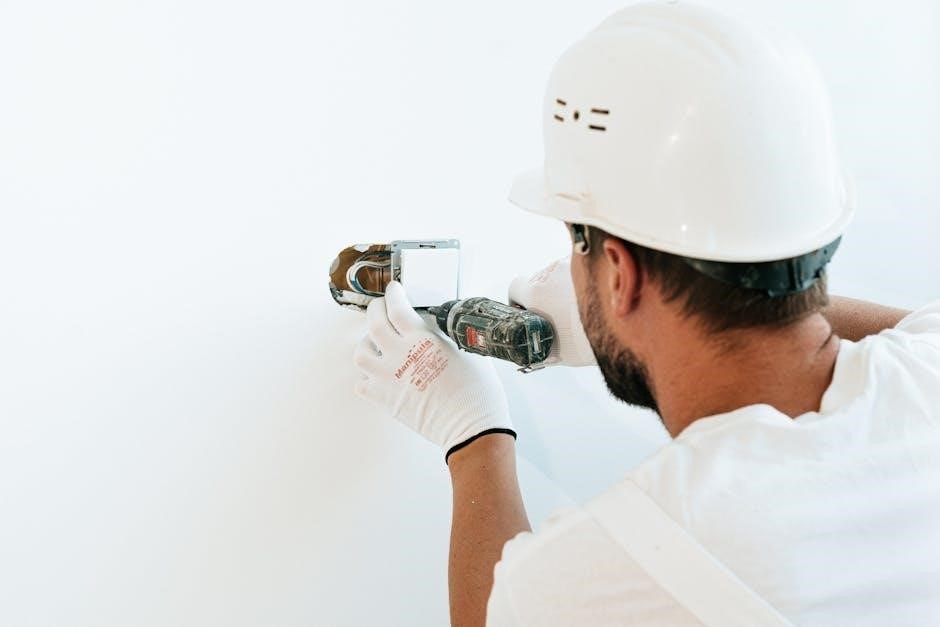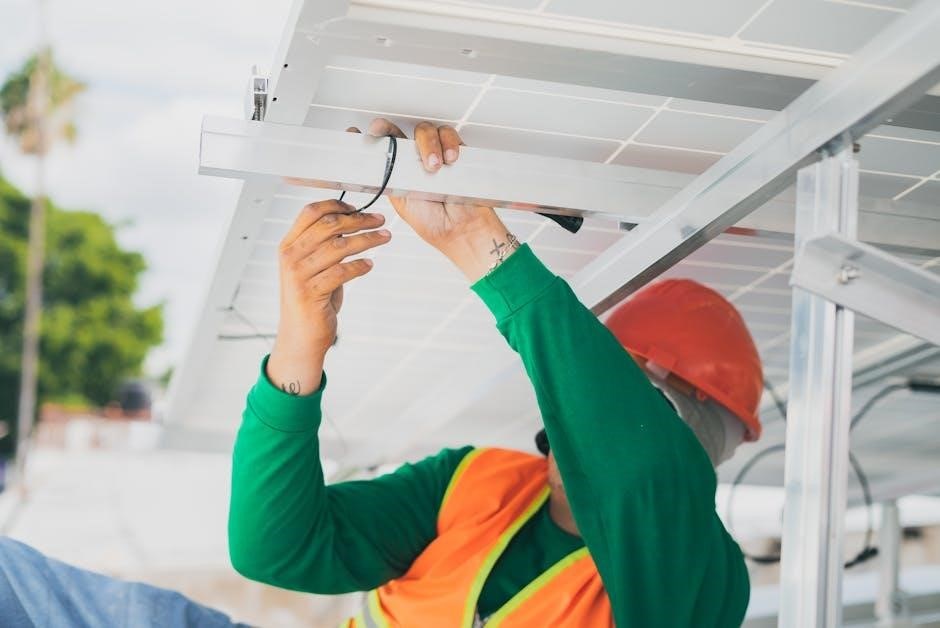The Honeywell RTH6580WF installation manual is a comprehensive guide for proper setup and operation, ensuring optimal performance of your HVAC system with detailed steps, features, and troubleshooting.
1.1 Overview of the RTH6580WF Thermostat
The Honeywell RTH6580WF is a Wi-Fi-enabled smart thermostat designed for seamless integration with HVAC systems. It offers remote monitoring, scheduling, and energy-saving features. Compatible with 24VAC systems, it supports forced air, hydronic, heat pumps, oil, gas, and electric systems but does not work with millivolt systems. The thermostat provides smart response technology for optimal temperature control and is user-friendly for both installation and operation, ensuring enhanced comfort and efficiency.
1.2 Importance of the Installation Manual
The installation manual is essential for correct setup and operation of the RTH6580WF thermostat. It provides step-by-step instructions, safety precautions, and troubleshooting tips, ensuring optimal performance. Without proper installation, the thermostat may not function correctly, leading to inefficiency or system damage. The manual also serves as a reference for maintenance and advanced features, helping users maximize energy savings and comfort. Following the guide ensures a smooth and safe installation process, guaranteeing long-term efficiency and system reliability.

System Compatibility and Requirements
The RTH6580WF is compatible with 24VAC HVAC systems, including forced air, hydronic, heat pumps, oil, gas, and electric systems. It does not support millivolt systems.
2.1 Compatible HVAC Systems
The Honeywell RTH6580WF is designed to work with 24VAC HVAC systems, including forced air, hydronic, heat pumps, oil, gas, and electric systems. It is not compatible with millivolt systems. This thermostat supports a wide range of heating and cooling configurations, making it versatile for various home setups. Ensure your HVAC system meets the 24VAC requirement before installation to guarantee proper functionality and compatibility. Always verify system specifications to avoid installation issues.
2.2 Electrical Requirements (24VAC Common)
The Honeywell RTH6580WF requires a 24VAC common electrical system to function properly. It is compatible with forced air, hydronic, heat pumps, oil, gas, and electric systems but does not support millivolt systems. Always verify your HVAC system’s compatibility with the 24VAC requirement before installation to ensure correct operation. Refer to your system’s manual or contact the manufacturer if unsure.

Pre-Installation Checklist
Ensure compatibility with your HVAC system, gather necessary tools like a screwdriver, and verify 24VAC common wiring before starting the installation process.
3.1 Tools and Materials Needed
To install the Honeywell RTH6580WF, gather essential tools and materials. A small screwdriver is required for wiring connections, and a wall anchor may be needed for mounting. Ensure you have the thermostat ID for registration and a computer or smartphone for Wi-Fi setup. Additional materials like wire labels and a voltage tester can be helpful. Refer to the manual for a detailed list and compatibility checks to ensure a smooth installation process.
3.2 Understanding the Thermostat Components
The Honeywell RTH6580WF thermostat features a touchscreen display for easy navigation and a sleek design. Key components include the wiring terminals, temperature sensors, and Wi-Fi connectivity module. The display provides real-time temperature readings and scheduling options. Familiarize yourself with the power button, navigation arrows, and home screen icons. The thermostat also includes smart sensors for advanced temperature and humidity monitoring. Understanding these components ensures proper installation and optimal functionality of the device. Refer to the manual for detailed diagrams and descriptions.
Step-by-Step Installation Guide
Begin by turning off power to the HVAC system. Remove the old thermostat, then wire the new RTH6580WF, ensuring correct terminal connections. Mount the thermostat and connect to Wi-Fi for initial setup.
4.1 Removing the Old Thermostat
Start by switching off the power to the HVAC system at the circuit breaker. Gently pull the wires away from the old thermostat’s terminals to avoid damage. Label each wire with its corresponding terminal for easy identification later. Remove the screws securing the old thermostat to the wall and carefully pull it away. If the thermostat is held by clips, use a screwdriver to pry it off. Finally, inspect the area for any leftover adhesive or debris before proceeding.
4.2 Wiring the RTH6580WF Thermostat
Begin by ensuring the power to the HVAC system is off at the circuit breaker. Locate the wires connected to the old thermostat and label them according to their terminals (e.g., R, W, Y, G, C). Match these wires to the corresponding terminals on the RTH6580WF, securing them tightly. Avoid forcing wires into incorrect terminals. If there are unused wires, leave them capped. Double-check all connections for accuracy. Proper wiring ensures smooth operation and integration with smart features.
4.3 Mounting the Thermostat
After wiring, mount the RTH6580WF thermostat to the wall plate, ensuring it is level and securely fastened. Attach the thermostat to the wall plate by aligning the tabs and gently pressing until it clicks. Avoid touching the screen during installation to prevent damage. Once mounted, plug in the wires through the designated openings and tighten the screws firmly. Ensure the thermostat is properly seated to maintain functionality and aesthetic appeal. Double-check alignment for a flush, professional installation.
Initial Setup and Configuration
After installing, connect the RTH6580WF to your Wi-Fi network and set up temperature schedules through the thermostat’s interface for optimal performance and personalized comfort.
5.1 Connecting to Wi-Fi
To connect your RTH6580WF thermostat to Wi-Fi, navigate to the menu, select the Wi-Fi option, and choose your network from the available list. Enter your password using the touchscreen interface. The thermostat will confirm the connection with an on-screen message or LED indicator. Ensure your router is within range and the network is 2.4 GHz for compatibility. A stable connection enables remote monitoring, scheduling, and smart features like Smart Response Technology.
5.2 Setting Up Temperature Schedules
Setting up temperature schedules on the RTH6580WF allows you to customize heating and cooling settings for different times of the day. Access the menu, select “Schedules,” and choose from pre-set options or create custom ones. Set your preferred temperatures for wake, leave, return, and sleep periods. The thermostat will automatically adjust to optimize comfort and energy use. Use the touchscreen to adjust schedules or enable energy-saving modes for added efficiency. Ensure schedules align with your lifestyle for optimal performance.

Advanced Features of the RTH6580WF
The RTH6580WF offers advanced features like Smart Response Technology for adaptive heating and cooling, remote monitoring via Wi-Fi, and energy-saving modes to optimize efficiency and comfort.
6.1 Smart Response Technology
The Honeywell RTH6580WF features Smart Response Technology, which learns and adapts to your HVAC system’s performance. This advanced feature optimizes heating and cooling cycles, ensuring consistent temperatures and improved efficiency. By anticipating your system’s needs, it minimizes temperature swings and enhances overall comfort. Smart Response Technology works seamlessly with the thermostat’s scheduling capabilities, providing a reliable and energy-efficient solution for your home’s climate control needs.
6.2 Remote Monitoring and Control
The Honeywell RTH6580WF allows remote monitoring and control through its Wi-Fi connectivity. Users can access and adjust temperature settings, view system status, and receive alerts via the Honeywell Home app. This feature enables seamless control from smartphones or tablets, providing convenience and flexibility. Remote monitoring ensures energy efficiency by allowing users to optimize their heating and cooling settings, even when away from home. This capability enhances comfort and reduces energy waste effectively.
6.3 Energy-Saving Modes
The Honeywell RTH6580WF features innovative energy-saving modes designed to optimize heating and cooling usage. These modes include smart response technology, which learns your system’s efficiency to minimize energy waste. The thermostat also offers eco-friendly settings that automatically adjust temperatures during peak hours or when the home is unoccupied. Additionally, pre-set energy-saving schedules help reduce consumption without compromising comfort. These modes ensure lower utility bills while maintaining optimal indoor conditions, making it an eco-friendly choice for homeowners.

Troubleshooting Common Issues
This section addresses common issues such as faulty wiring, temperature inaccuracies, and display malfunctions, providing solutions to ensure optimal thermostat performance.
7.1 Common Installation Errors
Common installation errors include incorrect wiring connections, such as misidentifying the 24VAC common wire or reversing live and neutral wires. Improper mounting can also occur, leading to sensor inaccuracy. Additionally, failure to turn off the HVAC system before installation may cause damage or safety hazards. Ensuring compatibility with existing systems and following step-by-step instructions can help avoid these issues.
7.2 Resolving Connectivity Problems
Ensure a stable internet connection and verify that the thermostat is connected to the correct Wi-Fi network. Restart both the router and thermostat to refresh the connection. Check for any physical obstructions or interference from other devices. If issues persist, consult the router settings to ensure the thermostat’s MAC address is allowed. Updating the thermostat’s firmware through the Honeywell Home app can also resolve connectivity problems. Moving the router closer to the thermostat may improve signal strength and ensure reliable operation.

Technical Specifications
The Honeywell RTH6580WF operates on 24VAC systems, compatible with gas, oil, electric, and heat pump configurations. It functions within 32°F to 90°F (0°C to 32°C) and 80% RH humidity, supporting Wi-Fi connectivity for remote control and smart home integration.
8.1 Operating Temperature Range
The Honeywell RTH6580WF thermostat operates effectively within a temperature range of 32°F to 90°F (0°C to 32°C). It is designed to function optimally in environments with a relative humidity of up to 80%. This range ensures reliable performance across various climates and HVAC systems, including gas, oil, electric, and heat pump configurations. Proper operation within these parameters guarantees efficient temperature control and system compatibility.
8.2 Humidity and Environmental Requirements
The Honeywell RTH6580WF thermostat is designed to operate in environments with a relative humidity of up to 80%. It is suitable for most indoor settings, including residential and light commercial spaces. The thermostat should be installed in a location protected from extreme temperatures, direct sunlight, and moisture. Avoid placing it near heating vents or drafty areas to ensure accurate temperature sensing and reliable performance. Proper environmental conditions are essential for optimal functionality and longevity of the device.

Warranty and Support Information
The Honeywell RTH6580WF is backed by a limited warranty, with dedicated customer support available through phone, email, or the Honeywell website for assistance and inquiries.
9.1 Manufacturer Warranty Details
The Honeywell RTH6580WF thermostat is covered under a limited warranty for parts and labor, typically spanning several years from the date of purchase. This warranty ensures defect-free materials and workmanship. It is non-transferable and requires proper installation as outlined in the manual. To claim warranty benefits, users must register the product and provide proof of purchase. Honeywell stands behind its products, offering reliable support for any issues within the warranty period. Always refer to the official manual for specific terms and regional variations.
9.2 Contacting Honeywell Support
For assistance with the Honeywell RTH6580WF, users can contact Honeywell Support through their official website or by phone. The support team is available to address installation, troubleshooting, and warranty-related queries. Additionally, Honeywell provides online resources, including FAQs and downloadable manuals, to help resolve common issues. Visit the Honeywell Home website or refer to the support section in the manual for contact details and regional support options. Timely assistance ensures optimal product performance and user satisfaction.
The Honeywell RTH6580WF installation manual provides a clear, step-by-step guide, ensuring successful setup and optimal performance of your smart thermostat for enhanced comfort and energy efficiency.
10.1 Final Tips for Optimal Performance
For optimal performance, ensure regular software updates, maintain a stable Wi-Fi connection, and clean the thermostat periodically. Schedule periodic checks of wiring and system compatibility. Utilize energy-saving modes and Smart Response Technology to enhance efficiency. Refer to the manual for troubleshooting common issues and follow maintenance recommendations to prolong the thermostat’s lifespan and ensure consistent operation.
10.2 Importance of Regular Maintenance
Regular maintenance ensures the Honeywell RTH6580WF operates efficiently and reliably. Clean the thermostat face and sensors periodically to avoid dust buildup that may affect accuracy. Check wiring connections to prevent loose contacts, which can cause malfunctions. Schedule annual inspections of the HVAC system to ensure compatibility and optimal performance. Regular maintenance helps prevent unexpected issues, extends the thermostat’s lifespan, and maintains energy efficiency, ensuring your home remains comfortable year-round.